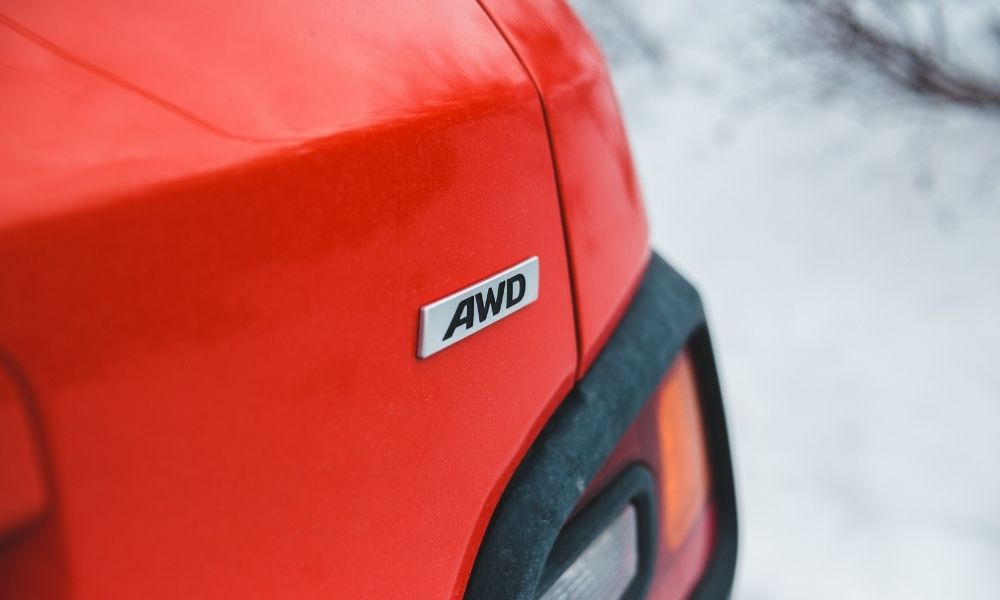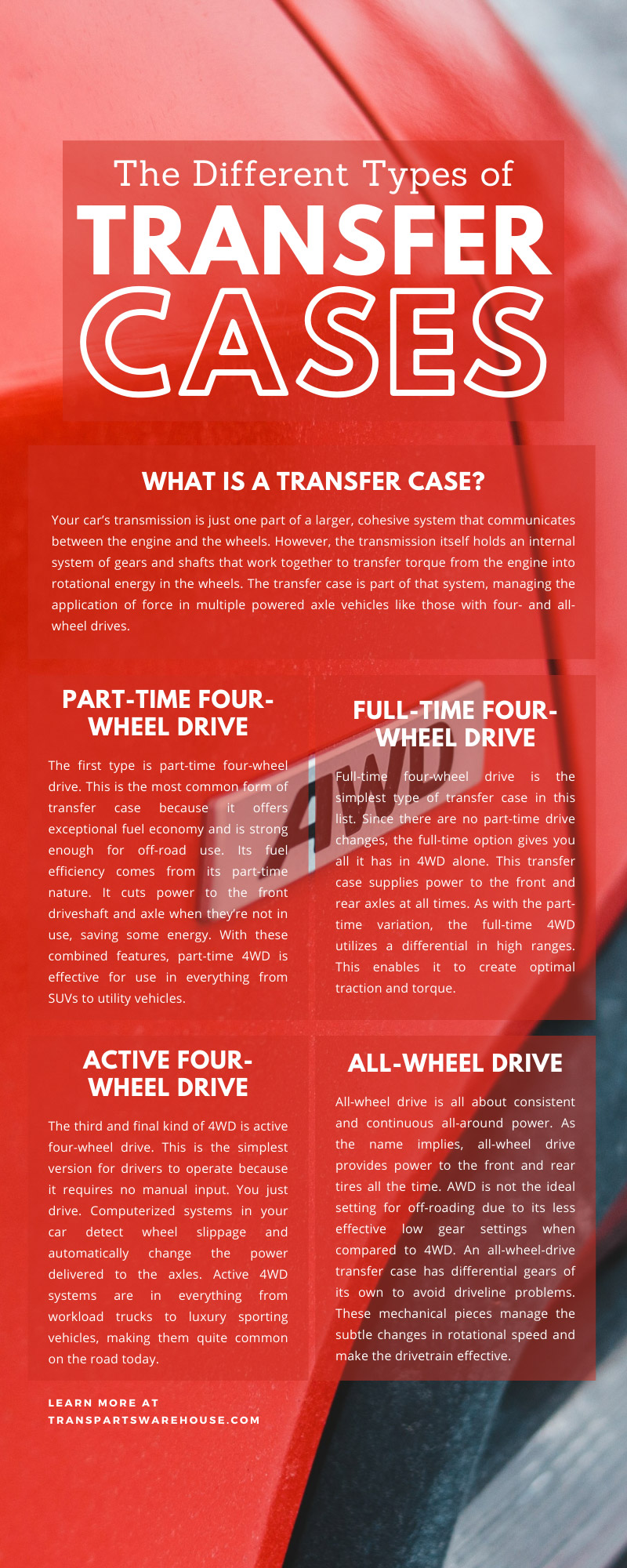
Your transmission directly influences your driving experience. It’s easy to imagine the difference between driving a manual and an automatic transmission vehicle. The transmission’s impact on drivability connects to everything from manual controls to terrain conditions. Explore the different types of transfer cases and how they each impact driving operations.
Transmission 101
The transfer case is one part of the broader transmission structure. You must grasp the scope and purpose of the transmission to understand the variety of transfer cases out there and how they each contribute something unique. Here’s more information on this fascinating vehicular component.
What Is a Transfer Case?
Before diving into the diverse and technical engineering world of transfer cases, let’s start at the beginning. What is a transfer case?
Your car’s transmission is just one part of a larger, cohesive system that communicates between the engine and the wheels. However, the transmission itself holds an internal system of gears and shafts that work together to transfer torque from the engine into rotational energy in the wheels. The transfer case is part of that system, managing the application of force in multiple powered axle vehicles like those with four- and all-wheel drives.
As its name implies, the transfer case transfers power from the transmission to the axles via drive shafts. By the time the mechanical energy and movement reach the transfer case, the transmission has already adjusted the gear settings and set the stage for the wheels. From there, the transfer case is responsible for taking that energy and turning it into a rotational movement that turns the axles and the wheels.
Why Do You Need It?
The transfer case acts as the back half of the transmission process. The engine cannot reach the wheels without the transmission. But, at the same time, the transmission cannot affect change without mechanical transference. A vehicle needs the transfer case to move the incoming power to the driveshafts, axles, wheels, and tires. Without this vital piece of the puzzle, you could never actually turn the wheels when you press the gas pedal.
The Main Types of Transfer Cases
There is no singular transfer case. The various operational and mechanical setups that exist in different vehicles force the transfer case to adapt. There are four primary kinds of transfer cases that you should know. They are the part-time four-wheel drive, full-time four-wheel drive, active four-wheel drive, and all-wheel drive. Read about them to figure out which one your vehicle uses to operate.
Part-Time Four-Wheel Drive
The first type is part-time four-wheel drive. This is the most common form of transfer case because it offers exceptional fuel economy and is strong enough for off-road use. Its fuel efficiency comes from its part-time nature. It cuts power to the front driveshaft and axle when they’re not in use, saving some energy. With these combined features, part-time 4WD is effective for use in everything from SUVs to utility vehicles.
Since a part-time four-wheel-drive transfer case only operates in 4WD some of the time, you may wonder what other drive options it has. The three driving modes this transfer case type offers are the following:
- Two-wheel drive: This drive only engages one set of wheels at a time—front or rear.
- Hi-range four-wheel drive (4Hi): This drive option utilizes a differential for maximum force.
- Low-range four-wheel drive (4Lo): This drive option is the default four-wheel engagement without a differential.
Full-Time Four-Wheel Drive
Full-time four-wheel drive is the simplest type of transfer case in this list. Since there are no part-time drive changes, the full-time option gives you all it has in 4WD alone. This transfer case supplies power to the front and rear axles at all times. As with the part-time variation, the full-time 4WD utilizes a differential in high ranges. This enables it to create optimal traction and torque. As a result, the vehicle holds to the ground more effectively, which is ideal for slippery surfaces. However, it’s not the best for dry pavement.
Active Four-Wheel Drive
The third and final kind of 4WD is active four-wheel drive. This is the simplest version for drivers to operate because it requires no manual input. You just drive. Computerized systems in your car detect wheel slippage and automatically change the power delivered to the axles. Active 4WD systems are in everything from workload trucks to luxury sporting vehicles, making them quite common on the road today.
All-Wheel Drive
All-wheel drive is all about consistent and continuous all-around power. As the name implies, all-wheel drive provides power to the front and rear tires all the time. AWD is not the ideal setting for off-roading due to its less effective low gear settings when compared to 4WD. An all-wheel-drive transfer case has differential gears of its own to avoid driveline problems. These mechanical pieces manage the subtle changes in rotational speed and make the drivetrain effective.
A Quick Note: The Difference Between AWD and 4WD
Four-wheel drive and all-wheel drive are quite comparable, and the differences may feel minute. But the distinctions are there, nonetheless. Mechanically, the two are similar. The core distinction between AWD and 4WD lies in their usage. All-wheel drive doesn’t engage all wheels all the time. Its moniker indicates the potential use of all tires. AWD cars will automatically switch between driving with one set of wheels to all four depending on outdoor slipperiness and traction conditions. On the other hand, 4WD cars utilize a central differential all the time, making them the better option for true off-roading scenarios.
Transfer Case Use and Care
Your car’s transfer case is always at work, whether it’s engaging 4WD or not. Due to this constant activation, wear will occur over time, and you must be ready to address it the moment it rears its ugly head. Inspect the transfer case fluid every time you get an oil change, whether you do it yourself or have a technician handle it. The most important things to look for are transfer case fluid leaks, contamination, metal particles, and dark coloring. If you see any of these, your transfer case needs immediate repair or replacement.
Knowing about the different types of transfer cases can help you make the best decision about what car to buy and what parts you need for transmission repairs. You can consult one of our transmission experts at Transparts Warehouse today. We’ll help you find suitable transfer case parts that fit your drive.


